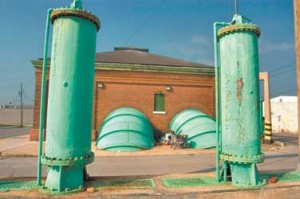New Orleans’ drainage rebuild will continue through 2018
11th May 2015 · 0 Comments
By Susan Buchanan
Contributing Writer
You’re tired of traffic detours around furrows on city streets but probably understand the need for new drainage canals. Work on the Southeast Louisiana Drainage Project or SELA, which dates back a decade, will continue for more than three years in some parts of town. New canals being built in Orleans and Jefferson parishes are intended to reduce rain-induced flooding. The U.S. Army Corps of Engineers is picking up most of what could be a more than $1 billion tab, with the Sewerage and Water Board of New Orleans and Jefferson Parish paying the rest.
Part of the city’s Uptown work should be finished this winter but that area’s Jefferson Avenue, where an underground canal is being built, won’t be done until 2017. A revamp of Louisiana Avenue’s drainage should wrap up in spring 2018. And in the Ninth Ward, a four-phased Florida Avenue rebuild is slated to end in late 2018.
Orleans projects include redoing a dozen drainage lines, boosting pump-station capacity and adding two new pump facilities. In Jefferson Parish, two dozen canals are being upgraded, capacity at four pump stations is being increased and two new stations are being added. The Harahan pump-to-the-river project is ongoing in Jefferson Parish. Improvements are also planned for St. Tammany Parish under SELA.
In New Orleans, “the SELA project is being built to work with the existing S&WB drainage system, which is designed to reduce flooding from a 10-year event of about nine inches of rain in 24 hours,” Army Corps spokesman Rene Poche said last week. Less storm water is expected to linger on streets than in the past. Water will disappear as the new canals convey it more quickly to storage underground and out to pump stations.
“Under SELA’s improvements in Uptown alone, the increased flow of 670,000 gallons per minute will be enough to drain an Olympic-size swimming pool in less than a minute,“ Poche said.
Funded construction for completed and ongoing work under SELA Orleans totals $891 million, Poche said. Of that, $639 million of work is under way now in the city. “So far, 60 of the 79 contracts funded and awarded in Orleans and Jefferson parishes have been completed,” he said. Out of 20 contracts awarded in Orleans Parish, 11 are finished. Forty-nine of the 59 contracts awarded in Jefferson Parish are fulfilled.
In New Orleans, the feds and their local partner, the S&WB, pay construction costs, with their shares dependent on how federal funds are provided, Poche said. Cost sharing ranges from 65 percent federal and 35 percent local, to 75 percent federal and 25 percent local, to 100 percent federal, depending on the project.
The state, which is often involved in cost sharing with the Corps, isn’t a funding partner in SELA Orleans. “The New Orleans Sewerage and Water Board and Jefferson Parish signed a Cooperative Endeavor Agreement saying they’d pay all portions due on behalf of the state,” Chip Kline, director of the state’s Coastal Protection and Restoration Authority, said last week.
As for the S&WB’s status within the city, it’s an independent entity. The New Orleans City Council and the local Board of Liquidation are responsible for approving its debt issuance, however. S&WB supplies water and sewer service to Orleans customers and drainage to the city and parts of Jefferson Parish. The drainage system it oversees is one of the world’s biggest.
Last fall, New-York based Fitch Ratings gave an “A minus” to $15 million in New Orleans Drainage System Refunding 2014 series bonds, sold in October. “Capital needs for the drainage system are extremely large following decades of deferred investment, in addition to repairs needed after Hurricane Katrina in 2005,” Fitch said. “Federal funding for the majority of capital will keep currently-low debt levels from rising dramatically over the near term.” But greater, local capital funding will be needed at some point, Fitch warned. The city’s drainage bonds are secured by property tax revenues.
As construction continues, the Army Corps is addressing nuisances to residents. “Non-impact, press-in hammers—which are quieter than typical, vibratory hammers—are being used in most of the contracts to install steel sheet piles,” Poche said. Insulators are installed around particularly noisy equipment. “But heavy construction methods, including installation of foundation timber piles, are rather loud,” he said. “That work is kept within city-mandated hours of work to minimize noise.”
Dust is a concern. “Some dust-control measures are dictated, and they include installing silt fencing around stored, earthen material and protecting catch basins with filter material,” Poche said. Other dust-abatement techniques, such as wetting piles of material and cleaning streets daily, are decided by the Corps and contractors, depending on the project.
SELA contractors include – Brothers Construction, based in New Orleans, and a host of others.
Public transit has been affected by drainage construction. From May 31 to July 11, the Regional Transit Authority will replace streetcar service with buses on the part of St. Charles Avenue between Erato and Webster Streets. To keep residents informed, the city launched an online tool early this year, tracking SELA and other street projects. The map can be found at roadwork.nola.gov on the web.
This article originally published in the May 11, 2015 print edition of The Louisiana Weekly newspaper.




